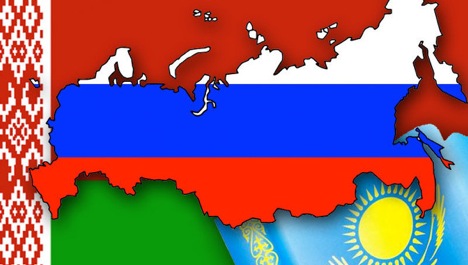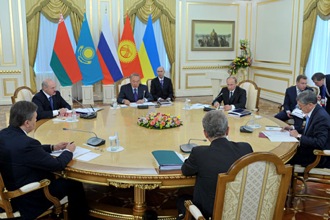The case for an FTA with India and the Customs Union

The advantages of establishing an FTA with India are noticeably greater than the drawbacks. Source: Press Photo
On October 24, during the meeting of the Supreme Eurasian Economic Council in Minsk, Russian president Vladimir Putin announced that India was showing interest in signing an agreement with the Customs Union on a free trade area.
In order to assess the outcome of the creation by the Customs Union of a free trade area (FTA) with India, it is necessary to first examine the current state of the Indian economy and this economy’s prospects. That being said, it is logical to take a comparative approach to this overview based on how matters stand in the Customs Union and the countries that are most likely to join it in the future: Kyrgyzstan, Armenia and Tajikistan.
An analysis of IMF statistics clearly shows that India leads in terms of such indicators as the proportion of its GDP based on purchasing power parity to the global economy, and the pace of the economy’s growth. India’s share of the world GDP rose from 3.06 percent in 1992 to 5.67 percent in 2012.
By comparison, among the current members of the Customs Union, growth in the share of the world GDP over this period is seen only in Kazakhstan and Belarus. Kazakhstan’s grew from 0.27 percent in 1992 to 0.28 percent in 2012, while Belarus’s increased from 0.16 percent to 0.18 percent. Unfortunately, between 1992 and 2012, Russia’s share of the world GDP dropped from 4.2 to 2.99 percent.
Of the countries that may join the organization, only Armenia showed some growth. From 1992 to 2012, Armenia’s GDP’s share of the world economy grew from 0.015 percent to 0.023 percent. Kyrgyzstan’s fell from 0.025 percent to 0.016 percent over that period, while Tajikistan’s dropped from 0.024 percent to 0.021 percent. This basic data demonstrates convincingly that India will not be a passive participant in a possible free trade area, but rather will be able to make a serious contribution to the development of the Customs Union, as it not only possesses an economy one and a half times larger than that of the member countries, but also shows faster economic growth.
Moreover, it should be taken into account that India was able to achieve such results thanks to unprecedented population growth: over the last two decades, its population rose by almost 50 percent, from 882 million to 1.211 billion people. Incidentally, in order to avoid similar problems of exploding population, China adopted strict measures to curtail births; according to experts, these measures prevented the births of 300 million people in the last three decades.
India has taken only isolated steps in this direction, and these steps did not achieve the necessary result. Unfortunately, of the active and potential members of the Customs Union, only Kyrgyzstan and Tajikistan could boast of population growth between 1992 and 2012, but, as is noted above, the share of these countries’ GDPs in the world GDP declined.
India has also managed to achieve respectable numbers when it comes to investments. According to 2012 data, investments climbed from 23.75 percent in 1992 to 35.5 percent of the total economy. This is higher than investment figures in any of the other Customs Union member countries or candidate countries. Belarus comes closest to India, with 33.7 percent according to 2012 figures. Kyrgyzstan is in second place, with 26.7 percent investments of the GDP; Russia is third, with 24.9 percent; Kazakhstan, fourth with 23.6 percent; Armenia, fifth with 22.5 percent; and Tajikistan, sixth with 16.7 percent.
Related:

Customs Union has “several positive aspects for India” - Khristenko
Three cheers for India’s FTA with Customs Union
India and the Customs Union: Towards greater economic integration
Most of the Customs Union countries prevail over India regarding the population’s per capita GDP based on purchasing power parity. In India, it was $3,800 per capita in 2012. Russia led with $17,500 at the end of 2012; Belarus was second, with $15,500; and Kazakhstan was third, with $13,500. Of the potential member countries, only Armenia has a higher level than India: its per capita GDP is $5,900. In Kyrgyzstan, this indicator is already significantly lower than India’s—$2,400—while in Tajikistan it is even lower, at $2,200.
The question may arise of why an FTA should be formed not with India, but with China, which has flourished significantly more than India in economic development over the last two decades. For example, its GDP’s share of the world GDP soared from 4.11 percent in 1992 to 14.74 percent by 2012. Unfortunately, a logical answer lies in the very posing of the question. China’s economy is inordinately potent for creating through the Customs Union an FTA with it in the coming years.
If such an area is created, the industrial sector of the countries participating in a Eurasian integration may embark on a prolonged crisis due to overwhelming competition with Chinese manufacturing, which is excessively efficient and more modern. Yet this definitely is not the idea of the integration processes in the post-Soviet territory.
In India’s case, one can expect more or less strong competition only in the textile and mining industries, pharmaceuticals and information technology. In these cases, it is possible to agree on quotas for supplying Indian goods and services; such quotas will minimize the risks for manufacturers in the Customs Union. The Customs Union countries will hold the obvious advantage in other industries.
An FTA does not create the risks that could arise in case of India’s full-fledged accession to the Customs Union, including an uncontrolled penetration of cheap labour. The advantages of establishing an FTA with India are noticeably greater than the drawbacks. These advantages include direct ones for Russia, which has already entered into close cooperation with India through BRICS.
First published in Russian in Vzglyad newspaper.
All rights reserved by Rossiyskaya Gazeta.
Subscribe
to our newsletter!
Get the week's best stories straight to your inbox
